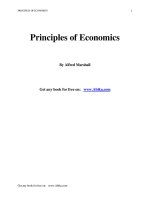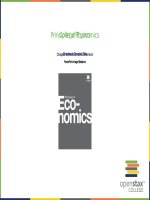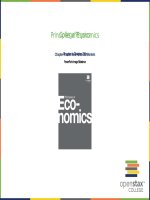Principles of economics openstax chapter2
Bạn đang xem bản rút gọn của tài liệu. Xem và tải ngay bản đầy đủ của tài liệu tại đây (273.94 KB, 20 trang )
College
Principles
ofPhysics
Economics
Chapter # Chapter Title
PowerPoint Image Slideshow
Chapter 2
Choice in a World of Scarcity
Choices & Trade-offs
In general, the higher the degree, the higher the salary. So why aren’t more people pursuing higher
degrees? The short answer: choices and tradeoffs.
Choices & Trade-offs
•
Individuals and societies make choices that bring them the largest benefits given
constraints they face.
•
To buy goods and services, the individual faces a budget constraint: the amount of
money available for spending.
•
To produce goods and services, the society faces a resource constraint: the supply
of labor, land, and capital available for production.
Choices & Trade-offs
Economics: the study of allocation and use of scarce
resources to satisfy unlimited human wants
To solve the economic problem, the society makes
choices.
Choices & Trade-offs
Opportunity cost is the unavoidable cost of making
choices.
•
•
Value of the best alternative forgone
What you give up to get something
Budget line
Each point on the budget constraint represents a combination of burgers and bus tickets Al can buy
with $10.
Slope of the line = 5/20 = $0.5/$2 = 0.25. Along the budget line, Al can give up 1 burger for 4 bus
tickets.
optimization
Optimization: Gaining the largest benefit from an action
Marginal Benefit: the increase in the benefit that results from an
action
Marginal Cost: the increase in the cost that results from an action
Optimization Rule:
Marginal Benefit = Marginal Cost
Production Possibilities Frontier
PPF is a graph showing the maximum amount of goods and
services that an economy can produce, assuming:
• Resources are fully employed
• Resources are limited in supply
• Technology is constant
Soda
Production Possibilities Frontier
S
X
Y
M
Z
P
0
Pizza
Production Possibilities Frontier
This PPF shows a trade-off between allocating resources to healthcare and education. At point A all resources go to
healthcare and at point B, most resources go to healthcare. At point D most resources go to education, and at F, all
resources go to education.
Production Possibilities Frontier
Slope of the PPF is a measure of opportunity cost of one good in
terms of the other good
The PPF is bowed-out when the opportunity cost of one good in
terms of the other good keeps rising.
The PPF becomes a straight line when the opportunity cost of one
good in terms of the other good stays constant.
Choices and trade-offs
Production Possibilities Frontier
Productive Efficiency: It is impossible to produce more of one good without
giving up some of the other good. Thus, all choices along a given PPF like
B, C, and D display productive efficiency, but R does not.
Allocative Efficiency: A specific combination of both goods on PPF
represents a desirable allocation.
Production Possibilities Frontier
Production Possibilities Frontier
Production Possibilities Frontier
The U.S. PPF is flatter than Brazil’s PPF since the opportunity cost of wheat
in terms of sugar cane is lower in the U.S. than in Brazil. Conversely, the
opportunity cost of sugar cane in terms of wheat is lower in Brazil.
The U.S. has “comparative advantage” in wheat production. Brazil has
“comparative advantage” in sugar cane production.
Production Possibilities Frontier
The economy can grow by expanding production of both goods with
•
•
Increased resources
Improved technology
Economic growth is show by an outward shift of the PPF.
PRODUCTION POSSIBILITIES FRONTIER
Economic Growth: PPF shifts outward
Choices and trade-offs
Both the individual’s budget line and the society’s PPF show the constraints
they face in making economic decisions.
Both diagrams show trade-off in choosing more of one good in terms of the
other good.
Choices and trade-offs









